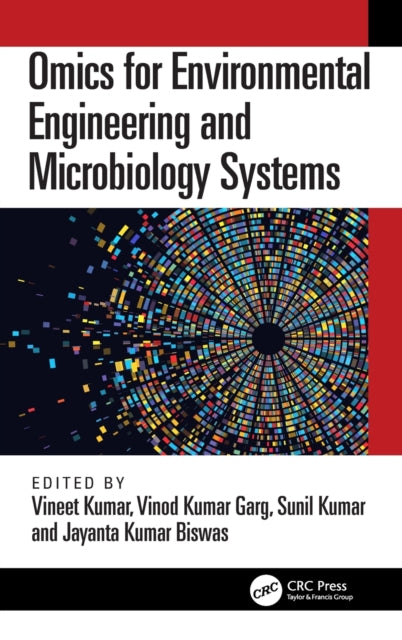Shulph Ink
Omics for Environmental Engineering and Microbiology Systems
Omics for Environmental Engineering and Microbiology Systems
YOU SAVE £8.88
- Condition: Brand new
- UK Delivery times: Usually arrives within 2 - 3 working days
- UK Shipping: Fee starts at £2.39. Subject to product weight & dimension
Bulk ordering. Want 15 or more copies? Get a personalised quote and bigger discounts. Learn more about bulk orders.
Couldn't load pickup availability
- More about Omics for Environmental Engineering and Microbiology Systems
Omics and microbial bioremediation are key areas of research and development for environmental pollution control. Metagenomics, metabolomics, fluxomics, bioremediation, and biodegradation of industrial wastes are covered, as well as metagenomic methodologies and best practices for taxonomies. Microbial degradation pathways and detoxification mechanisms for organic and inorganic contaminants of wastewater are also explored.
Format: Hardback
Length: 522 pages
Publication date: 07 November 2022
Publisher: Taylor & Francis Ltd
Environmental pollution is a significant global concern that has been exacerbated by human activities and technological advancements. The release of harmful pollutants into the environment, such as chemicals, heavy metals, and organic compounds, has detrimental effects on human health, wildlife, and ecosystems. In response to this challenge, researchers and scientists have been working tirelessly to develop innovative solutions to control and mitigate environmental pollution.
One area of research that has gained significant attention in recent years is the field of omics. Omics refers to the comprehensive study of biological systems using advanced technologies such as genomics, proteomics, and metabolomics. By analyzing the vast amounts of data generated by these technologies, researchers can gain a deeper understanding of the complex interactions between different organisms and their environment.
One of the key applications of omics in environmental pollution control is the identification and characterization of toxic pollutants. By analyzing the genetic makeup and metabolic pathways of harmful microorganisms, researchers can develop targeted strategies to remove or neutralize these pollutants from the environment. For example, metagenomics, a branch of omics that involves the analysis of genetic material from environmental samples, has been used to identify novel bacteria and fungi that can degrade industrial waste and other pollutants.
Another important area of research in environmental pollution control is microbial bioremediation. Microbial bioremediation involves the use of microorganisms to remove or degrade pollutants from contaminated environments. This approach is highly effective and cost-efficient, as microorganisms can be grown and deployed in large quantities at relatively low costs. Microbial bioremediation has been used successfully to clean up contaminated sites, such as oil spills, landfills, and industrial waste sites.
In addition to microbial bioremediation, other broad environmental pollution control approaches such as metagenomics, metabolomics, fluxomics, and biodegradation of industrial wastes have also been developed. Metagenomics involves the analysis of genetic material from environmental samples to identify the diverse range of microorganisms present in a particular environment. Metabolomics, on the other hand, involves the analysis of the metabolites produced by microorganisms to gain insight into their metabolic pathways and potential for degradation. Fluxomics, meanwhile, involves the analysis of the flow of nutrients and other chemicals through biological systems.
Biodegradation of industrial wastes is another important area of research in environmental pollution control. Industrial waste often contains harmful chemicals and pollutants that can be difficult to remove through conventional methods such as incineration and landfilling. Biodegradation involves the use of microorganisms to break down these pollutants into harmless compounds. This approach is environmentally friendly and cost-effective, as it does not require the development of new technologies or the disposal of hazardous waste.
Metagenomics and waste management are also important areas of research in environmental pollution control. Metagenomics involves the analysis of genetic material from environmental samples to identify the microbial communities present in a particular environment. This information can be used to develop targeted waste management strategies, such as composting or bioremediation, that are specific to the microbial communities present in a particular waste stream.
Recycling for environmental cleanup is another important area of research in environmental pollution control. Recycling involves the reuse of materials that would otherwise be disposed of as waste. By recycling, we can reduce the amount of waste that is sent to landfills and incinerators, which can have negative environmental impacts. Recycling can also reduce the demand for raw materials, which can help to conserve natural resources and reduce greenhouse gas emissions.
In conclusion, environmental pollution is a significant global concern that has been exacerbated by human activities and technological advancements. The development of innovative solutions to control and mitigate environmental pollution is critical to ensuring a sustainable future for our planet. Omics, microbial bioremediation, metagenomics, metabolomics, fluxomics, and biodegradation of industrial wastes are just a few of the areas of research that have been developed to address this challenge. By continuing to invest in research and development in these areas, we can develop more effective and sustainable solutions to control environmental pollution and protect our environment.
Weight: 1174g
Dimension: 234 x 156 (mm)
ISBN-13: 9781032162836
This item can be found in:
UK and International shipping information
UK and International shipping information
UK Delivery and returns information:
- Delivery within 2 - 3 days when ordering in the UK.
- Shipping fee for UK customers from £2.39. Fully tracked shipping service available.
- Returns policy: Return within 30 days of receipt for full refund.
International deliveries:
Shulph Ink now ships to Australia, Belgium, Canada, France, Germany, Ireland, Italy, India, Luxembourg Saudi Arabia, Singapore, Spain, Netherlands, New Zealand, United Arab Emirates, United States of America.
- Delivery times: within 5 - 10 days for international orders.
- Shipping fee: charges vary for overseas orders. Only tracked services are available for most international orders. Some countries have untracked shipping options.
- Customs charges: If ordering to addresses outside the United Kingdom, you may or may not incur additional customs and duties fees during local delivery.


